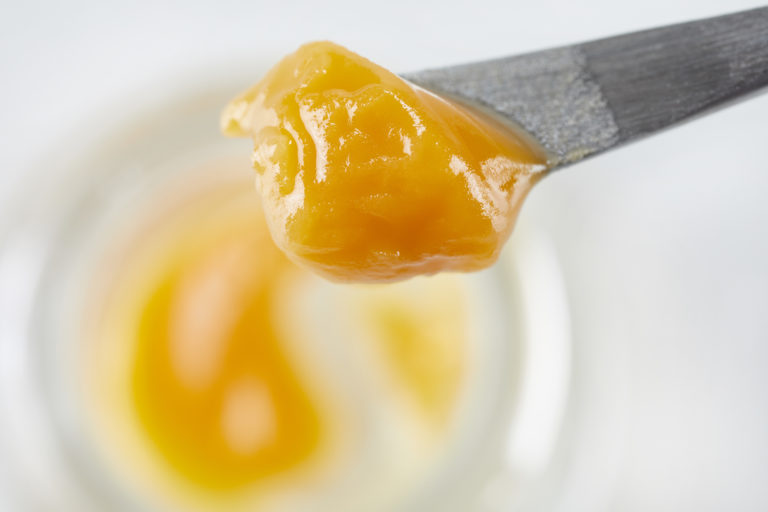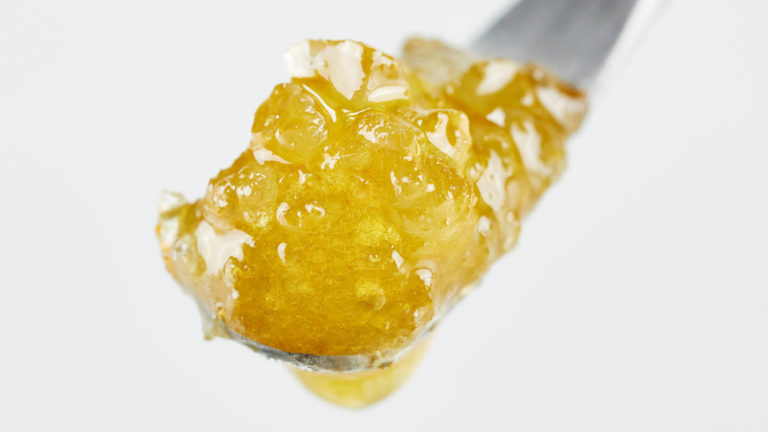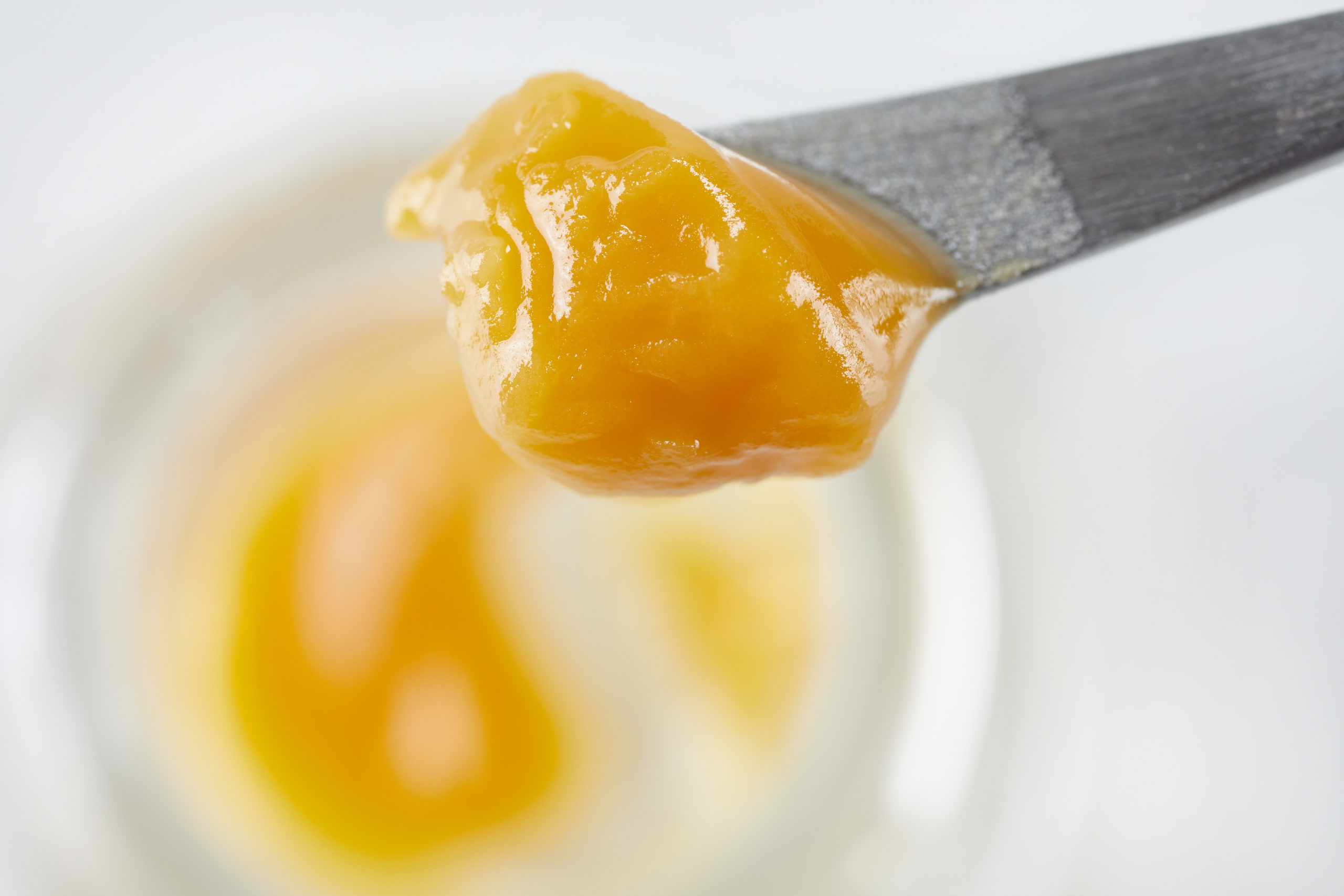A cannabis concentrate produced that preserves the full cannabinoid and terpene contents of the raw cannabis plant. The goal of a full-spectrum extract is to maintain the complex range of desirable compounds in a cannabis plant without altering them through decarboxylation or oxidation. Full Spectrum Cannabis Oil (FSCO) and Full Extract Cannabis Oil (FECO) are common designations synonymous with full spectrum extract. Popular extracts that may be considered full spectrum include sauce, live resin, High Terpene Full Spectrum Extract (HTFSE), and High Cannabinoid Full Spectrum Extract (HCFSE).
Do you know if this sauce is a full spectrum extract?
If you're looking for better cannabis flavor, try this High Terpene Full Spectrum Extract.
 Photo by: Gina Coleman/Weedmaps
Photo by: Gina Coleman/WeedmapsImage lightbox

What does full-spectrum mean?
In its raw form, each cannabis cultivar has its own unique cannabinoid and terpene profile that, among other compounds, contribute to their therapeutic effects. These compounds are created within the plant's lipid and fat-based trichomes. A full-spectrum extract is a type of cannabis concentrate that aims to capture all of the therapeutic compounds of the raw cannabis plant at the moment that it was processed, without the lipids and fats that hold those compounds together but do not have medicinal benefits.
In a cannabis context, the term spectrum is used to describe the range of compounds produced by the plant's trichome glands that can potentially produce therapeutic effects. In other words, the full spectrum means the full range of compounds that are produced within the trichome gland.
The goal of a full-spectrum extract is to capture all of the available compounds from the trichomes without altering them, leaving behind the undesirable fats, waxes, and lipids that hold the desirable compounds together.
The cannabis plant can produce more than 400 compounds. Aside from the well-known cannabinoids (THC, CBD, THCA, etc.), cannabis plants produce a wide range of compounds that may potentially have therapeutic uses. These therapeutic compounds include aromatic terpenes, flavonoids, proteins, phenols, and esters. A full spectrum extract seeks to capture and retain each of these compounds for human consumption.
For instance, a full-spectrum CBD extract will strive to maintain the other compounds of the cannabis plant, including trace amounts of the intoxicating cannabinoid THC. In this case, the biggest advantage of using full-spectrum cannabidiol (CBD) oil over broad-spectrum or CBD isolate, both of which fully remove THC during the extraction process, is a phenomena most commonly referred to as the “entourage effect.” This term is used to describe the highly beneficial synergistic relationship that different cannabinoids, terpenes, and other compounds have when combined.
Each cultivar, or cultivated variety of the cannabis plant, produces a unique chemical profile — the production and expression of which is greatly influenced by environment. Terpene content is strongly inherited, for example, while the total terpene yield per weight of plant tissue is much more dependent on environmental factors. Each unique chemical profile makes up the unique spectrum offered by a given cultivar. That's why it's possible for two plants of the same cultivar to have differing chemical profiles, especially when subjected to different environmental stresses during cultivation.
One of the most important features of a full-spectrum cannabis extraction is that it preserves the nature of the extracted compounds. The acidic forms of cannabinoids found in the plant (THCA, CBDA, CBGA) are not decarboxylated in the process.

Image lightbox

Decarboxylation is when a compound loses carbon atoms and releases carbon dioxide, either by heat or prolonged overexposure to environmental stress. THCA, for example, does not produce intoxicating effects until it is decarboxylated into the active compound THC. Acidic cannabinoids may decarboxylate into neutral forms on their own, however, depending on the conditions of drying and storage processes. Acidic cannabinoids may offer therapeutic benefits that differ from that of their neutral counterparts, so users may not want to use extracts that have been decarboxylated.
Full-spectrum extracts preserve cannabinoids in their acidic form.
How the spectrum changes during cultivation and after harvest
The cannabis plant will produce an ever-evolving set of compounds while the plant is growing. Cannabinoids and terpenes are produced in the trichome through biosynthesis, in which enzymes catalyze a series of chemical reactions to produce complex molecules from simple (smaller) molecules. Think of enzymes as tiny biological machines that use chemical energy rather than mechanical energy to build structures — namely terpenes and acidic cannabinoids.
These compounds begin to change once the plant is harvested, altering the spectrum of available compounds. Terpenes, for example, are either oxidized and become terpenoids or can be lost during the drying process. When cannabis is dried and cured, terpene atoms are oxidized, and the terpene becomes a terpenoid.
Studies have found that upwards of 30% of monoterpenes (terpenes with two isoprene units — as opposed to the three isoprene units of sesquiterpenes, four isoprene units of diterpenes, and so on) produced during the flowering phase are lost in the drying process. This loss of monoterpenes will change the spectrum of available compounds in dried and cured cannabis. This tells us that the full spectrum of available compounds is actually relative to the point in which those compounds are removed.
Say you harvest a Sour Diesel plant and split it into two halves. You flash-freeze the first half to preserve all of the compounds that were available at the moment of harvest. This will ensure that none of the temperature-sensitive terpenes is lost. The second half, you dry and cure using traditional drying methods.
During this process, we lose some of the terpenes, and what's left will most likely be altered by oxygen to some extent.
At this point, both halves have a different spectrum of compounds ready to be extracted. If an extractor were to successfully remove all compounds from each half, both could be labeled a full-spectrum extract, even though they don't have the same available spectrum.
The first product could be considered a Live Resin Full Spectrum Extract while the latter could be labeled a Cured Nug or Whole Plant Full Spectrum Extract.
The spectrum of available compounds will vary greatly from cultivar to cultivar, and its chemical makeup will largely depend on when it was extracted from the plant. Both genetic and environmental factors are fully at play in creating the spectrum of compounds ultimately expressed by any given cultivar.
Plant material and how it affects the spectrum
Which extracts are considered full spectrum?
The term full-spectrum extract is used relatively frequently to describe a variety of popular extracts. You may have heard, for instance, of Full Spectrum Cannabis Oil (FSCO) or Full Extract Cannabis Oil (FECO). Maybe you've heard of both and wondered what the difference was between them.
The truth is, these terms generally mean the exact same thing, and both are used synonymously with the term full spectrum extract. FSCO and FECO oil are simply different terms used to describe an extract that preserves the raw plant's full spectrum of compounds.
Now let's take a look at other cannabis concentrates that are frequently labeled Full Spectrum Extracts and see if they meet the criteria:
Sauce
Sauce (or terp sauce, as it's frequently called) is a non-uniform extract with a sticky, liquid consistency. It's completely void of the plant's lipid-rich exterior, and contains most if not all of the plant's available compounds. Sauce extracts contain high levels of terpenes, which in turn makes them exceptionally flavorful.
Sauce can be a full-spectrum product, but it's not guaranteed. While it may be free of the plant's fats and waxes, the process of removing the solvent may alter some of the available compounds. Altering or losing compounds during extraction will technically deprive sauce of full-spectrum status, but even sauce that isn't full spectrum will come exceptionally close to retaining all available compounds of the raw plant.
Live resin
Extracts made using plant material that was frozen immediately after harvest are considered live resin. Their purpose is to maintain the full spectrum available at the moment of harvest and emit an aroma as potent as that of a live plant.
The label Live Resin Full Spectrum Extract would explicitly tell a consumer that the extract contains all of the compounds that were available at the moment of harvest. These extracts are considered the most flavorful and aromatic concentrates on the market. Live resin isn't guaranteed to be a full-spectrum extract, but because they contain extracted monoterpenes usually lost during the drying period, live resin extracts will always contain a higher ratio of monoterpenes than any other extract.
What does high terpene full spectrum extract (HTFSE) & high cannabinoid full spectrum extract (HCFSE) mean?
High Terpene Full Spectrum Extract (HTFSE) and High Cannabinoid Full Spectrum Extract (HCFSE) describe the two fractions that occur when a full-spectrum extract is made from cured flowers. HTFSEs are composed of roughly 50% THCA and anywhere from 13% to 40% terpenes. High Cannabinoid Full Spectrum Extracts are roughly 90% THCA. While the spectrum within an HTFSE or HCFSE are not the same as that of a live plant, it is still considered full spectrum because it has captured all of the available compounds at the time of extraction.
Rick Simpson Oil
Rick Simpson Oil (RSO) is an unrefined, potent cannabis oil extracted using ethanol or naphtha, and named after the Canadian engineer who created it.
FECO vs. RSO — Is RSO full spectrum?
RSO is not a full-spectrum extract, though it's commonly mislabeled as such. While the extract contains almost all of the trichomes' available compounds, the process of adding heat to remove the solvent decarboxylates the major acidic cannabinoids into their neutral form and can potentially alter the terpenes.
The RSO extraction process is also done using room-temperature solvents, which extracts all of the plant's fats and waxes. These are the two main reasons that RSO is not considered a full-spectrum extract, under this strict interpretation of the term, though it's still an incredibly useful extract that can benefit many different medical marijuana patients.
Sources
Elsohly, Mahmoud A., and Desmond Slade. “Chemical Constituents of Marijuana: The Complex Mixture of Natural Cannabinoids.” Life Sciences, vol. 78, no. 5, 22 Dec. 2005, pp. 539–548., doi:10.1016/j.lfs.2005.09.011.
Casano, S., et al. “Variations In Terpene Profiles Of Different Strains Of Cannabis Sativa L.” Acta Horticulturae, no. 925, 2011, pp. 115–121., doi:10.17660/actahortic.2011.925.15.
Andre, Christelle M., et al. “Cannabis Sativa: The Plant of the Thousand and One Molecules.” Frontiers in Plant Science, vol. 7, 4 Feb. 2016, doi:10.3389/fpls.2016.00019.
Dvory, Namdar, et al., “Variation in the Compositions of Cannabinoid and Terpenoids in Cannabis Sativa Derived from Inflorescence Position along the Stem and Extraction Methods.” Industrial Crops and Products, vol. 113, Mar. 2018, pp. 376–382., doi:10.1016/j.indcrop.2018.01.060.

